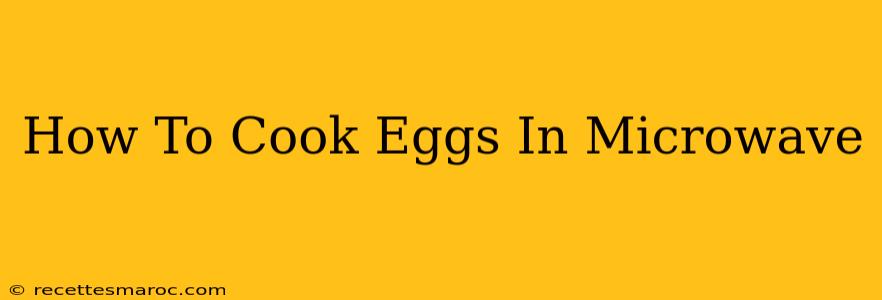Cooking eggs in the microwave might seem unconventional, but it's a surprisingly quick and efficient method for a single-serving breakfast or snack. This guide will walk you through several methods, ensuring perfectly cooked eggs every time, avoiding the dreaded rubbery texture.
Choosing Your Egg Cooking Method
The microwave offers several ways to cook eggs, each with its own advantages and quirks. Let's explore the most popular options:
1. Scrambled Eggs in a Mug: The Classic Microwave Egg
This is the simplest and fastest method. You'll need:
- 1 egg: Larger eggs might require slightly longer cooking times.
- 1 tablespoon milk or water (optional): This adds fluffiness.
- Salt and pepper to taste: Season to your preference.
- Microwave-safe mug: Make sure it's large enough to avoid spills.
Instructions:
- Crack the egg into the mug.
- Add milk or water (if using) and seasonings.
- Whisk vigorously until the yolk and white are fully combined.
- Microwave on high for 30-60 seconds, checking frequently. Cooking time will depend on your microwave's power and the size of your mug. Start with shorter intervals to avoid overcooking.
- Once cooked through, let it sit for a minute before enjoying.
Tips for Perfect Scrambled Microwave Eggs:
- Don't overcook! It's better to slightly undercook and let the residual heat finish the job.
- Stir halfway through: This ensures even cooking and prevents a rubbery texture.
- Experiment with add-ins: Cheese, chopped vegetables, or hot sauce can easily be incorporated.
2. Microwave Poached Eggs: A Healthier Option
Poached eggs in the microwave are surprisingly easy and a healthier alternative to fried eggs. You'll need:
- 1 egg: Fresh eggs work best.
- 1 tablespoon water: Creates steam for poaching.
- Microwave-safe bowl or mug: A shallow dish works well.
- Vinegar (optional): A splash of vinegar helps the egg white set more quickly.
Instructions:
- Add the water to the bowl.
- Crack the egg directly into the water. Add vinegar (if using).
- Microwave on high for 45-60 seconds. Again, check frequently and adjust cooking time as needed.
- Carefully remove the egg with a slotted spoon.
Tips for Perfect Microwave Poached Eggs:
- Cover the bowl: This helps create a steamy environment for poaching.
- Don't overcook: The yolk should be slightly runny.
- Use a paper towel: To blot away excess water before serving.
3. Microwave Omelet: A More Advanced Technique
Microwave omelets require a bit more finesse but are a great way to enjoy a more substantial egg dish.
- 2 eggs: More eggs will require a longer cooking time.
- Fillings of your choice: Cheese, vegetables, ham, etc.
- Microwave-safe, flat dish: This helps distribute heat evenly.
Instructions:
- Whisk the eggs.
- Add your chosen fillings.
- Pour the egg mixture into the dish.
- Microwave on high for 1-2 minutes, checking for doneness. The center should be just set.
Tips for Perfect Microwave Omelets:
- Fold the omelet: Once cooked, carefully fold it in half.
- Don't overcrowd the dish: This will make it difficult to cook evenly.
- Lower power setting: Experiment with a lower microwave power setting to prevent burning.
Troubleshooting Common Microwave Egg Problems
- Rubbery eggs: This usually happens due to overcooking. Reduce the cooking time and check more frequently.
- Unevenly cooked eggs: Stir halfway through cooking, or use a flatter dish for more even heat distribution.
- Exploding eggs: Make sure your eggs are fresh and not cracked before microwaving.
Beyond the Basics: Creative Microwave Egg Recipes
Once you master the basics, experiment! Add different seasonings, vegetables, cheeses, and meats to create your own unique microwave egg recipes. The possibilities are endless! Enjoy your quick and easy microwave eggs!

